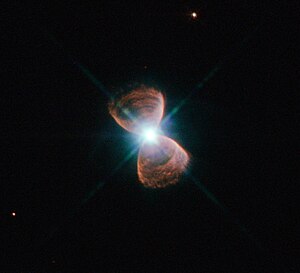Portal:Radiation astronomy/Resource/40
Nebulas
[edit | edit source]
"Hubble astronomers have found an unexpected surprise while surveying more than 100 planetary nebulae in the central bulge of our Milky Way galaxy. Those nebulae that are butterfly-shaped or hourglass-shaped tend to be mysteriously aligned such that their rotation axis is perpendicular to the plane of our galaxy."[1]
"Astronomers have used the NASA/ESA Hubble Space Telescope and ESO's New Technology Telescope to explore more than 100 planetary nebulae in the central bulge of our galaxy. They have found that butterfly-shaped members of this cosmic family tend to be mysteriously aligned — a surprising result given their different histories and varied properties."[2]
"Planetary nebulae are the expanding gaseous shrouds encircling dying stars. A subset of this population has bipolar outflows that align to the star's rotation axis. Such nebulae formed in different places and have different characteristics and so it is a puzzle why they should always point on the same sky direction, like bowling pins set up in an alley."[1]
"All these nebulae formed in different places and have different characteristics. Neither the individual nebulae, nor the stars that formed them, interact with other planetary nebulae. However, a new study by astronomers from the University of Manchester, UK, now shows surprising similarities between some of these nebulae: many of them line up in the sky in the same way. The "long axis" of a bipolar planetary nebula slices though the wings of the butterfly, whilst the "short axis" slices through the body."[2]
"The astronomers looked at 130 planetary nebulae in the Milky Way's central bulge. They identified three different types, and peered closely at their characteristics and appearance. The shapes of the planetary nebula images were classified into three types, following conventions: elliptical, either with or without an aligned internal structure, and bipolar."[2]
"This really is a surprising find and, if it holds true, a very important one, [...] Many of these ghostly butterflies appear to have their long axes aligned along the plane of our galaxy. By using images from both Hubble and the NTT we could get a really good view of these objects, so we could study them in great detail."[2]
"While two of these populations were completely randomly aligned in the sky, as expected, we found that the third — the bipolar nebulae — showed a surprising preference for a particular alignment, [...] While any alignment at all is a surprise, to have it in the crowded central region of the galaxy is even more unexpected."[1]
"Planetary nebulae are thought to be sculpted by the rotation of the star system from which they form. This is dependent on the properties of this system — for example, whether it is a binary [A binary system consists of two stars rotating around their common centre of gravity.], or has a number of planets orbiting it, both of which may greatly influence the form of the blown bubble. The shapes of bipolar nebulae are some of the most extreme, and are thought to be caused by jets blowing mass outwards from the star system perpendicular to its orbit."[1]
"The alignment we're seeing for these bipolar nebulae indicates something bizarre about star systems within the central bulge, [...] For them to line up in the way we see, the star systems that formed these nebulae would have to be rotating perpendicular to the interstellar clouds from which they formed, which is very strange."[2]
"While the properties of their progenitor stars do shape these nebulae, this new finding hints at another more mysterious factor. Along with these complex stellar characteristics are those of our Milky Way; the whole central bulge rotates around the galactic centre. This bulge may have a greater influence than previously thought over our entire galaxy — via its magnetic fields. The astronomers suggest that the orderly behaviour of the planetary nebulae could have been caused by the presence of strong magnetic fields as the bulge formed."[2]
"Researchers suggest that there is something bizarre about star systems within the central hub of our galaxy. They would all have to be rotating perpendicular to the interstellar clouds from which they formed. At present, the best guess is that the alignment is caused by strong magnetic fields that were present when the galactic bulge formed billions of years ago."[1]
"As such nebulae closer to home do not line up in the same orderly way, these fields would have to have been many times stronger than they are in our present-day neighbourhood. Very little is known about the origin and characteristics of the magnetic fields that were present in our galaxy when it was young, so it is unclear how they have changed over time."[2]
"We can learn a lot from studying these objects, [...] If they really behave in this unexpected way, it has consequences for not just the past of individual stars, but for the past of our whole galaxy."[1]
References
[edit | edit source]- ↑ 1.0 1.1 1.2 1.3 1.4 1.5 A. Zijlstra (September 4, 2013). Some Planetary Nebulae Have Bizarre Alignment to Our Galaxy. Baltimore, Maryland USA: Hubble Site. http://hubblesite.org/newscenter/archive/releases/nebula/2013/37/. Retrieved 2014-02-26.
- ↑ 2.0 2.1 2.2 2.3 2.4 2.5 2.6 Bryan Rees; Albert A. Zijlstra; Nicky Guttridge (September 4, 2013). Bizarre alignment of planetary nebulae. ESA Space Telescope. http://www.spacetelescope.org/news/heic1316/. Retrieved 2014-02-26.
